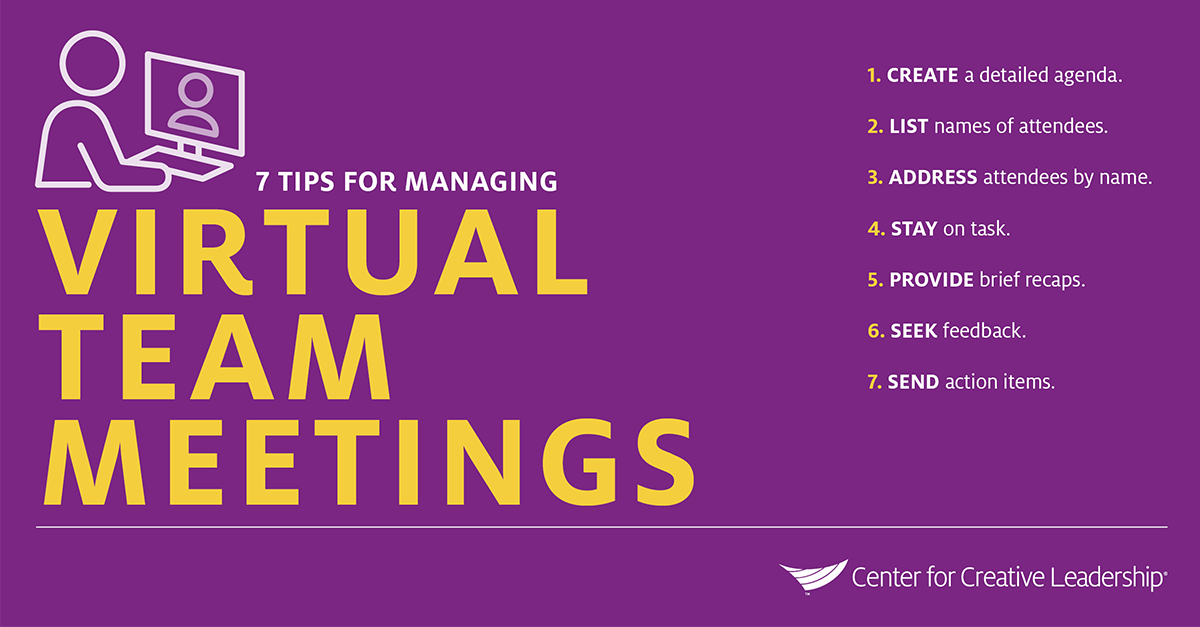As the world navigates the coronavirus pandemic, a swath of the global workforce has set up shop to work from home.
With a new emphasis on telecommuting comes a new reality: Teams need a strategy for communicating digitally, and leaders must adapt in order to effectively manage their people and meetings remotely.
Most people who’ve worked remotely can attest that while virtual teamwork has its pros, it can also be challenging. According to our research, some of the specific limitations of managing virtual teams include some people participating more than others, difficulty in dealing with conflict, and trouble developing trust.
The frustration team members experience is often compounded by technological glitches on calls, connectivity issues, and team members’ different expectations about comfort and use of technology.
To overcome these challenges while taking advantage of the opportunities, we suggest the following 3 tips for remote collaboration and problem-solving while managing virtual teams.
3 Tips for Managing Virtual Teams
Research-Backed Recommendations
These tips are taken from our research white paper on managing virtual teams.
1. Use technology to communicate in real-time and to train and develop your people.
The more often team members meet “face-to-face” through real-time technologies, the higher their levels of success. That’s because tools like videoconferencing allow for members to interpret non-verbal communication, like hand gestures, facial expressions, and body posture. As a result, communication feels more familiar and natural. These are important considerations for a strong virtual persona and effective virtual communication.
Organizations can help by providing training in technologies and tools.
A survey of 440 professionals across 8 different industries (conducted before the current coronavirus crisis) found that more than 60% of organizations didn’t provide training for virtual team leaders or members. Of the organizations that did offer some training, more than 80% of these respondents indicated virtual training wasn’t a priority.
Especially for teams with few existing relationships, training is necessary to help members get off on the right foot with new technologies and tools.
To streamline communications, training should detail which tools will be used for what purposes. This will prevent the same information being sent via multiple mediums and keep work from falling through the cracks.
2. Overcome time zone differences.
Teams that spread across multiple time zones can easily fall into the trap of working long hours to accommodate one another’s schedules. This is especially a concern during a time of global crisis when people working from home experience blurred boundaries between personal and professional obligations. Be aware that because of the long work hours, your people may be on a path to burnout, as they find it hard to separate from, or “turn off,” work.
When teams are geographically dispersed, you can do the following to better manage virtual teams and protect members from burnout:
- Ensure members are able to get the bulk of their work done during their normal working hours.
- Provide tools for scheduling and guidelines on “connectivity” to minimize early morning or late-night meetings. Global virtual teams especially need clarity on when they should (or shouldn’t) be available, including on weekends and local holidays.
- Provide extra organizational support for recovery practices and formalize team norms. More geographically dispersed teams tend to have lower levels of team commitment, so these teams may benefit from additional opportunities to meet face-to-face at key times throughout a project.
- Ensure that successes are visible and celebrated to help build team commitment and keep up morale.
Remember that even though employees are often willing to work extra hours in the short-term when it feels necessary and unavoidable, these long hours are not sustainable. Above all, acknowledge that equipping your people to handle stress, uncertainty, and setbacks results in more resilient team members who are prepared for future challenges, and a more resilient organization as a whole.
3. Consider team members’ other commitments.
Employees can only be stretched so far, and the more teams they’re involved with, the less time they’re able to devote to each project. Take the following steps to ensure your members are engaged.
- Ensure teams are of optimal size. Our research has found that means you should aim for 5–9 members.
- Be aware of the number of teams on which members simultaneously work. Not surprisingly, the more teams someone is on, the less effective they are.
- Determine whether team members are core or peripheral. Core team members are key contributors who are highly involved and stay involved over a longer time. Peripheral team members support the team’s work but may be involved in a lesser way or for a shorter time. At the beginning of a project, explain each team member’s role and expected contribution.
- Avoid overloading high performers with too many team assignments. Limit the roles they play (particularly if they’re core team members) to prevent them from becoming overwhelmed and burning out. When the economic pendulum inevitably swings back at some point, you want to be sure you have retained your high potentials, and you don’t want your top talent to be depleted, as they will make up your leadership pipeline and can help power your organization into the future.
Management Checklist for Designing & Supporting Virtual Teams
Creating the right conditions for virtual teamwork to succeed is imperative in the early stages of a team’s development. The following checklist can help you design your teams and enhance the teams’ future performances.
- Clearly articulate vision and corporate objectives to all employees. This is even more important in times of crisis.
- Select team members based on individual talents and abilities, including technical competence and interpersonal skills.
- Once you’ve established teams, instruct team leads to clearly define the team’s mission and purpose so that all team members are on the same page.
- Establish processes for sharing information, making decisions, and resolving miscommunications or potential conflicts.
- If possible, set up a communication channel for process questions/discussions that’s separate from the task-related communications.
- Clearly define and communicate the tools teams have for communicating with one another on a regular basis.
- Ensure team members have clear goals and recommend potential approaches to perform work.
- Recognize individual and team efforts through rewards and other performance incentives.
Best Practices for Leading & Managing Virtual Team Meetings
From a distance, it can be hard for participants to contribute to a meeting. Make things easier by taking these steps:
- Create a detailed agenda and send it out ahead of time, so people know what to expect and come prepared.
- List the names of attendees at the start of the meeting, so everyone is reminded of who’s there.
- Address attendees by name when verbally interacting with participants, and provide opportunities for all attendees to contribute.
- Stay on task in order to keep the group engaged and to keep people away from the temptation to multitask.
- Provide brief recaps as you move through the agenda, restating what the collective input is before you move onto the next item.
- Seek feedback and provide via all communication channels.
- Send out action items in a meeting recap to all participants after the meeting to reiterate what was decided upon and what the next steps are.
Above all, keep communication lines open to ensure everyone is on the same page and aligned and working together to achieve your shared goal.
Leading More Mindful Virtual Meetings
3 Keys to Virtual Meeting Success
Why do some virtual team meetings feel like a waste of time, while others feel essential and productive? The difference is being mindful about ensuring the meeting is a good use of everyone’s time. Consider these 3 characteristics that distinguish the most useful meetings from the rest:
1. Everyone participating feels the agenda couldn’t be addressed without the meeting.
Most things don’t require meetings — an email will do. Pretending to need people’s input does not require a meeting; just announce the decision that’s already been made. No one has illusions about that — we all see the results of past discussions.
But some things require human interaction and collaborative thinking, like problems we don’t have solutions to yet or conflicts that haven’t been fully explored. If we need to take time to let creative solutions emerge, a meeting may be needed.
2. Everyone necessary is fully present.
How many meetings are you part of where others are invested in their smartphones or doing other work, checking into the meeting only every so often? Or where some members only perk up to really listen when the boss speaks?
This isn’t accomplished by nagging on the part of the team leader; it’s accomplished by a meeting agenda that focuses the conversation on decisions that make a difference.
3. Agreement has been achieved on what we’ll accomplish and the kinds of conversations we’ll use to get results.
What will the deliverables be? Information sharing? Traffic management? Decisions? Preliminary decisions for further research? Decide so we’re all going to work toward delivering what we owe each other? What kind of conversations? Issues that we need to explore or conclude?
An agenda should include what is needed from each item, and it should be shared in advance so decisions can be made in a timely way. People shouldn’t hear about something for the first time at a meeting.
Ready to Take the Next Step?
Prepare your leaders for the ever-changing needs of the new world of work — including leading virtual team meetings more effectively — with our solutions for leading virtual & remote teams.







